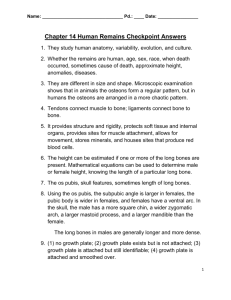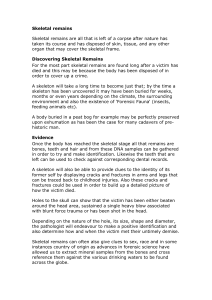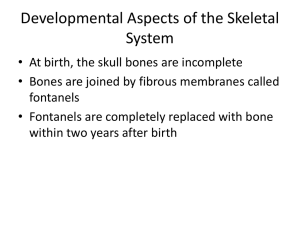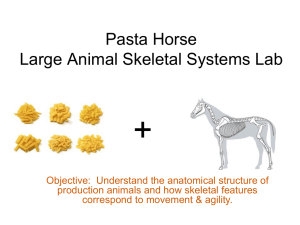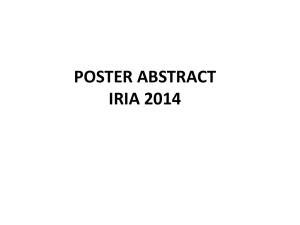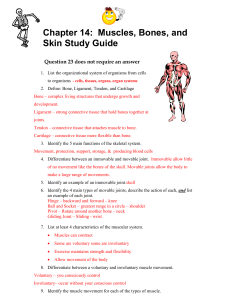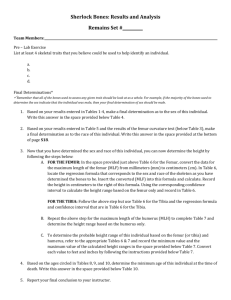Exemplar 1.2.3 Bone Detective Report- Worton
advertisement
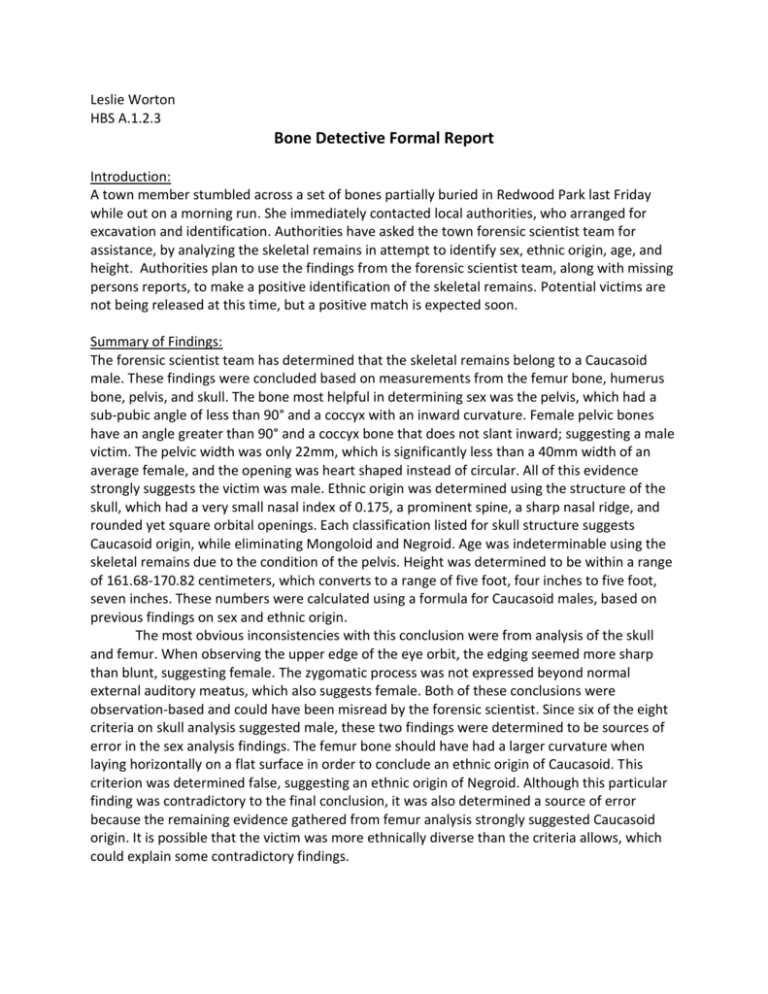
Leslie Worton HBS A.1.2.3 Bone Detective Formal Report Introduction: A town member stumbled across a set of bones partially buried in Redwood Park last Friday while out on a morning run. She immediately contacted local authorities, who arranged for excavation and identification. Authorities have asked the town forensic scientist team for assistance, by analyzing the skeletal remains in attempt to identify sex, ethnic origin, age, and height. Authorities plan to use the findings from the forensic scientist team, along with missing persons reports, to make a positive identification of the skeletal remains. Potential victims are not being released at this time, but a positive match is expected soon. Summary of Findings: The forensic scientist team has determined that the skeletal remains belong to a Caucasoid male. These findings were concluded based on measurements from the femur bone, humerus bone, pelvis, and skull. The bone most helpful in determining sex was the pelvis, which had a sub-pubic angle of less than 90° and a coccyx with an inward curvature. Female pelvic bones have an angle greater than 90° and a coccyx bone that does not slant inward; suggesting a male victim. The pelvic width was only 22mm, which is significantly less than a 40mm width of an average female, and the opening was heart shaped instead of circular. All of this evidence strongly suggests the victim was male. Ethnic origin was determined using the structure of the skull, which had a very small nasal index of 0.175, a prominent spine, a sharp nasal ridge, and rounded yet square orbital openings. Each classification listed for skull structure suggests Caucasoid origin, while eliminating Mongoloid and Negroid. Age was indeterminable using the skeletal remains due to the condition of the pelvis. Height was determined to be within a range of 161.68-170.82 centimeters, which converts to a range of five foot, four inches to five foot, seven inches. These numbers were calculated using a formula for Caucasoid males, based on previous findings on sex and ethnic origin. The most obvious inconsistencies with this conclusion were from analysis of the skull and femur. When observing the upper edge of the eye orbit, the edging seemed more sharp than blunt, suggesting female. The zygomatic process was not expressed beyond normal external auditory meatus, which also suggests female. Both of these conclusions were observation-based and could have been misread by the forensic scientist. Since six of the eight criteria on skull analysis suggested male, these two findings were determined to be sources of error in the sex analysis findings. The femur bone should have had a larger curvature when laying horizontally on a flat surface in order to conclude an ethnic origin of Caucasoid. This criterion was determined false, suggesting an ethnic origin of Negroid. Although this particular finding was contradictory to the final conclusion, it was also determined a source of error because the remaining evidence gathered from femur analysis strongly suggested Caucasoid origin. It is possible that the victim was more ethnically diverse than the criteria allows, which could explain some contradictory findings. Further Analysis: Facial reconstruction is a technique that uses modeling clay and known tissue thickness, based on sex and ethnic origin data, to sculpt a model of a face onto a skull. The technique is used to identify skeletal remains, by comparing the sculpture to pictures of missing persons, in order to subjectively match remains to victims. Facial reconstruction generally asks a living relative to view the model to determine if it could possibly be the missing person in question. This technique would only be useful in this particular case once the police department identifies a list of potential missing victims. Using that list, the victims could be eliminated one-by-one, until ideally a single individual is identified. There are other scientific methods for identifying skeletal remains that reduce experimental error. One of these techniques is testing mitochondrial DNA found in the bone of the remains, and comparing it to mitochondrial DNA from the maternal lineage of possible victims. To complete this test, PCR and electrophoresis tests would need to be conducted, comparing mitochondrial DNA samples from relatives of missing victims against the skeletal remains. If DNA bands from the electrophoresis gel of the skeletal remains match up to the bands from the sample of relatives, then a positive identification could be made. This technique would be more accurate because it’s a comparison that utilizes hard evidence and side-by-side analysis of the DNA. Another testing method is to work with the evidence, matching quantitative and qualitative data from the skeletal remains to what is found in the reports gathered by investigators. For example, taking an x-ray of the skeletal remains might uncover a bone fracture. Based on the amount of healing, forensic scientists could then determine a time frame for the injury and match to hospital reports of potential missing victims. They could also use dental records, assuming teeth are still found in the skulls of the remains, to make a positive identification. Conclusion: After full forensic analysis of the skeletal remains, it has been determined that the victim is a Caucasoid male who was 5’4” to 5’7” in height. Findings were based on extensive review of the skull, pelvis, femur, and humerus bones in order to confidently eliminate the possibility of the remains being female or of Mongoloid or Negroid ethnic origin. The next step should be to analyze DNA samples from the bones and compare them to samples from all missing victims who match the description of evidence gathered so far. These samples can be compared through gel electrophoresis to determine if any of the missing victims are a positive match to the skeletal remains found.

